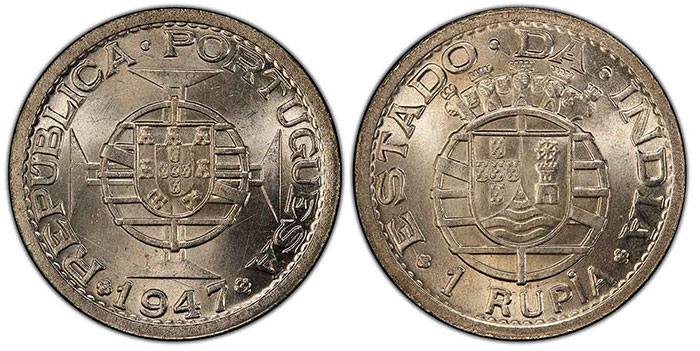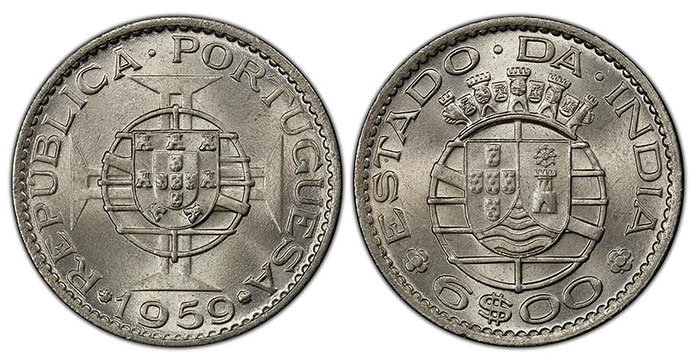By Jay Turner for PCGS ……
Throughout the long and complicated history of Colonial India, Portugal had the longest span of all the European colonizers.

Beginning as early as 1498, colonial rule by Portugal continued in India until 1961 — a full 13 years past 1948, when British colonial control famously ended and India became an independent republic. Between the 16th and the 18th centuries, Portuguese colonies dotted the costs of India. Such colonial outposts would include places like Bom Bahia (future Bombay and Mumbai), which was given as a wedding gift to Charles II of England in 1662 and allowed that country to have a colonial foothold in India.

Yet as other European colonizers expanded their power and influence around the world, Portugal was left with just a few colonial areas that lasted until the 20th century. These areas include Diu, Damao (Daman), Dadra, Nagar-Aveli (Nagar Haveli), and Goa and would make up the Portuguese colonies left in India in the 20th century that collectively were known as Estado da India.
End of Portuguese Rule
With India gaining independence from Britain in 1947 and the formation of the Republic of India, the remaining European colonies on the Indian subcontinent became an issue.
On February 27, 1950, the Government of the Republic of India formally requested that Portuguese open negotiations about the future of Portuguese colonies in India. Portugal’s response was that all territories were not colonies but part of metropolitan Portugal, hence any idea of transfer was non-negotiable. The argument was Goa was Portuguese for over 440 years and the Republic of India, less than three years old, had no claim to Portugal or its lands. India went on to withdraw its diplomatic mission from Lisbon in 1953.


The first territorial loss of its colonies to the Republic of India came with the annexation of Dadar and Nagar Haveli. These two Portuguese colonial areas were landlocked and surrounded by Indian territory. The Indian government had started a policy of isolation against these two areas in 1952 by not allowing Portuguese to cross their land to access these territories. Pro-Indian groups, with the support of the Indian Police Force, began to launch assaults against Dadra and Nagar Haveli and would succeed in capturing the police stations in 1954. Portugal appealed the annexation of Dadar and Nagar Haveli to the International Court of Justice, which ruled on April 12, 1960 that Portugal had sovereign rights over the territories but that India also had the right to deny passage over their land to access these territories.
In 1954, India began a blockade of Diu, Damao, and Goa and a military buildup in preparation for their annexation. Portuguese efforts to reinforce their navy were foiled by President Nasser of Egypt, who denied the ships access to the Suez Canal. In fear of the coming war, Europeans in Goa fled despite Portuguese government orders not to do so.
On December 11, 1961, the Indian Army advanced into Goa. Daman and Diu were both attacked on December 18, 1961. On that day a Portuguese request to the United Nations for a debate on the conflict in Goa was made and approved. The resolution that was passed asked for the immediate cessation of hostilities and for India to withdraw forces. Yet by December 18, Goa had been all but captured by India. The president of Portugal demanded that Goa be destroyed before being given up to India but Governor General Manuel Antonio Vassalo e Silva ordered forces to cease-fire and officially surrendered, ending the 451-year Portuguese rule in Goa.
As a result of the loss of Goa and other Portuguese colonial territories in India, relationships between India and Portugal wouldn’t be reestablished until 1974. Portugal offered all Goa native peoples citizenship and did the same for those who wished to emigrate to Portugal rather than remain and live under Indian rule; this would be amended in 2006 to only those born before December 19, 1961. India found support for its actions from the Soviet Union, Arab states, African states, and neighboring Ceylon. Condemnation came from the United States, the United Kingdom, the Netherlands, Brazil, and Pakistan.
The Last Coinage of Portuguese Rule
The coinage of Portuguese India is a long and diverse topic. However, the last coinage of Portuguese India before annexation is one that covers a span of only a few years.

Prior to 1958, the coinage of Portuguese India was on the rupia system, which started around 1668 and lasted until 1958. After 1871, the rupia was equal to that of the Indian rupee and the subdivision of such (the tanga was equal to the Indian anna). It would take 16 tangas to make one rupia and a rupia was worth 60 reis. The last rupia was issued in 1952 and replaced in 1958 by the escudo system.
The Portuguese India escudo system was divisible by 100, with one escudo worth 100 centavos. The coins were issued and circulated in Diu, Damao, and Goa until annexation by India in 1961 and demonetization in 1962. The set of the last coinage of Portuguese India contains 12 coins and is as follows:
- 10 Centavos: 1958, 1959, 1961
- 30 Centavos: 1958, 1959
- 60 Centavos: 1958, 1959
- Escudo: 1958, 1959
- 3 Escudos: 1958, 1959
- 6 Escudos: 1959
All of these coins have a high survival rate and can be found in uncirculated condition, but finding Gem quality is difficult.
As time progresses, what was once a prickly political issue becomes accepted. With governmental change in Portugal in 1974, the recognition of Indian sovereignty took place. While the annexation of the colonies is still considered illegal under UN Charter, the Supreme Court of India has found it legal. Some 60 years after the events of 1961, no one can reasonably dispute that Goa is India, and yet for over 450 years it was Portuguese.
With coinage, we can hold artifacts in our hands that show moments in time. For the last coinage of Portuguese India, we see a fledgling nation unite a country in a cause to end colonial occupation — or, likewise, we see colonial power losing its territory after four centuries.
* * *






The forgotten and the passed rulers, kings, qeens are remember ,is only Coinage and some forts ,temples which are constricted by them and which are remainder till today is the only evidence.